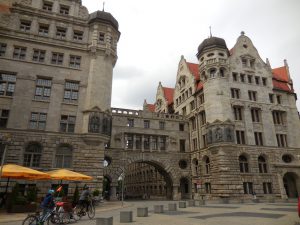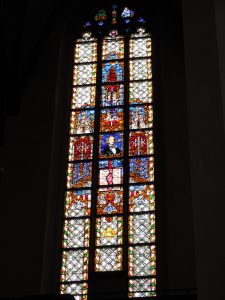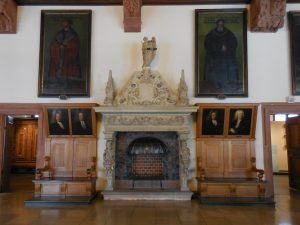Leipzig, Germany
By Tracy A. Burns
The many faces of Leipzig
 Leipzig is architecture – daring modern projects plus gems in historicist, Baroque, Renaissance and Jugendstadt styles dot the city center. Leipzig is music. This is the city of Bach, Schumann, Wagner, Mendelssohn and Mahler. It has been a center of trade since the Middle Ages, and its book fair dates back to the 17th century. Leipzig is also a university town, a tradition that goes back to the 15th century. Goethe and Nietzsche studied in this town. Now more than 40, 000 students obtain a higher-level education here. Once dubbed “Little Paris,” Leipzig more recently earned the nicknames “The Boomtown of the East” and “The new Berlin.”
Leipzig is architecture – daring modern projects plus gems in historicist, Baroque, Renaissance and Jugendstadt styles dot the city center. Leipzig is music. This is the city of Bach, Schumann, Wagner, Mendelssohn and Mahler. It has been a center of trade since the Middle Ages, and its book fair dates back to the 17th century. Leipzig is also a university town, a tradition that goes back to the 15th century. Goethe and Nietzsche studied in this town. Now more than 40, 000 students obtain a higher-level education here. Once dubbed “Little Paris,” Leipzig more recently earned the nicknames “The Boomtown of the East” and “The new Berlin.”
A city full of opportunities
Watch a Glockenspiel of Meissen china in the Mädler Passage, modelled after the Galleria Vittorio Emanuele II in Milan, or visit Bach’s grave in the Church of St. Thomas, or gaze at the largest monkey house in the world in the zoo or have a beer at Auerbach’s Cellar, a tavern that Goethe once frequented. If beer is not your beverage of choice, savor a coffee at the Coffee Baum, a place where famous composers used to gather. Don’t forget to walk around one of Europe’s largest squares, the Augustusplatz and to visit the Church of St. Nicholas, the starting point for the 1989 October revolution in Leipzig. Take time out to dine at the quaint inner court of Dor Aliewatsch, where there are more than 30 restaurants and bars.
City history through the Battle of Nations
Leipzig’s name derives from the Slavic word Lipsk, which translates as “a settlement where the linden trees stand.” The town was first mentioned in writing during 1015, and markets took place here as early as the 12th century. The university was established in 1409, and Leipzig soon became a renowned center of education. During the 18th century, it made a name for itself in book publishing, and would continue to excel in this trade until World War II. The 1813 Battle of Nations, the largest battle in the world up to World War I, took place near Leipzig. A defeated Napoleon ordered his troops to withdraw from Germany. (Don’t miss the monument to this battle on the outskirts of town.)
From the German Empire through the 1989 Revolution
The German Empire was set up in 1871, and before World War I, Leipzig flourished. Leipzig was part of the Weimar Republic from 1918 to 1933. It experienced the Roaring Twenties and the Great Depression of 1929. In 1933 the Hitler- led National Socialists took over. Much of the city was damaged by bombing during the war. On April 18, 1945 US soldiers liberated Leipzig, but that July the Americans turned the city over to the Soviets. The German Democratic Republic or East Germany was born in 1949. The citizens of Leipzig played a major role in the toppling of the Communist regime in October of 1989, after 40 years of totalitarian rule.
The Church of St. Nicholas
 The Church of St. Nicholas, the largest church in the city, was where its citizens gathered to protest the Communist regime in 1989 and where prayers for peace have been held since the early 1980s. Bach used to perform here, and Martin Luther preached here when he introduced the Reformation to the city. Although it was built in Romanesque style in 1165, the church took on a Gothic character in the early 16th century. The interior has been classicist in style since the end of the 18th century. Check out the columns with palm tree capitals, pink and green in color.
The Church of St. Nicholas, the largest church in the city, was where its citizens gathered to protest the Communist regime in 1989 and where prayers for peace have been held since the early 1980s. Bach used to perform here, and Martin Luther preached here when he introduced the Reformation to the city. Although it was built in Romanesque style in 1165, the church took on a Gothic character in the early 16th century. The interior has been classicist in style since the end of the 18th century. Check out the columns with palm tree capitals, pink and green in color.
The Church of St. Thomas
Bach served as cantor for a lengthy period at the Church of St. Thomas that has a Late Gothic exterior from the 15th century. The interior is Neo-Gothic, and its 76-meter roof is one of the steepest in the country. The stained glass windows are to be admired, too.
The Old Town Hall
 Dating from 1556, the Old Town Hall holds the distinction of being the first Renaissance hall in Germany. The administration moved to other premises in 1905, and shortly afterwards that the Museum of City History was established. Experience Leipzig’s history through paintings, furnishings, sculpture and other objects in this architectural gem.
Dating from 1556, the Old Town Hall holds the distinction of being the first Renaissance hall in Germany. The administration moved to other premises in 1905, and shortly afterwards that the Museum of City History was established. Experience Leipzig’s history through paintings, furnishings, sculpture and other objects in this architectural gem.
The New Town Hall
Constructed from 1899 to 1905, the New Town Hall boasts a design based on the Palazzo Vecchio in Florence and ranks among the largest town halls in the world. The tower measures 1,147 meters in height.
Museums
Don’t miss out on the museums, either – there are over 30 to choose from. The Grassi Museum complex includes the Ethnography Museum, the Applied Arts Museum and the Musical Instruments Museum. The Museum of Antiquities and the Museum of Fine Arts are other possibilities.
An eclectic, modern and historic town
Leipzig has a variety of opportunities for tourists of many interests. Architecture, music, museums – these are just a few of the possibilities in this both modern and historic town.



